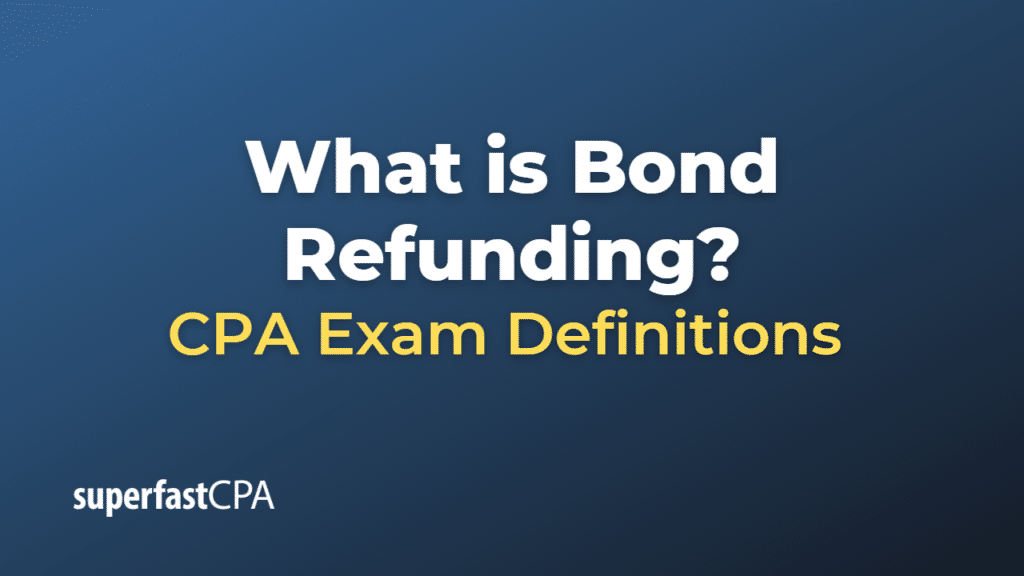Bond Refunding
Bond refunding is a financial strategy used by bond issuers, typically corporations or governmental entities, to refinance their outstanding bonds by issuing new bonds at a lower interest rate. This is usually done when market interest rates have decreased, allowing the issuer to replace the existing bonds with new bonds that have a lower cost of borrowing. The primary objective of bond refunding is to reduce the issuer’s interest expenses and, in some cases, to restructure the debt’s maturity profile or modify restrictive bond covenants.
There are two main types of bond refunding:
- Current refunding: This occurs when the issuer calls (redeems) the outstanding bonds before their maturity and uses the proceeds from the issuance of new bonds to retire the existing bonds immediately. Current refunding usually takes place within 90 days of the call date. This approach allows the issuer to take advantage of lower interest rates immediately and reduce interest expenses.
- Advance refunding: In this case, the issuer sells new bonds and uses the proceeds to purchase a portfolio of government securities (usually U.S. Treasury bonds) that are placed in an escrow account. The interest and principal payments from the escrowed securities are used to pay off the outstanding bonds when they reach their call date or maturity. Advance refunding effectively locks in the lower interest rate on the new bonds while the old bonds are still outstanding. It is often done when the existing bonds have a call protection period or if the issuer wants to spread out the financial impact of the refunding.
Bond refunding can be a complex process involving legal, accounting, and financial considerations. Issuers must carefully evaluate the potential benefits and costs of refunding, including the fees associated with issuing new bonds, the call premium on the existing bonds, and the potential tax implications for bondholders. If the savings from the lower interest rates on the new bonds are greater than the costs associated with the refunding process, bond refunding may be a beneficial strategy for the issuer.
Example of Bond Refunding
Let’s consider a hypothetical example of a city government that decides to undertake a bond refunding to take advantage of lower interest rates.
City A issued 20-year municipal bonds with a face value of $50,000,000 and a 5% coupon rate ten years ago to fund the construction of a new public library. The bonds have a call provision that allows the city to redeem them after ten years. Now, the current market interest rates have dropped to 3%.
City A sees an opportunity to save on interest expenses by refunding the outstanding bonds with new bonds at the lower interest rate. The city decides to proceed with a current refunding, as the bonds are now callable.
Here’s how the bond refunding process would work in this example:
- City A issues new 10-year municipal bonds with a face value of $50,000,000 and a 3% coupon rate, raising $50,000,000 in proceeds.
- The city uses the proceeds from the new bond issuance to redeem the outstanding bonds, paying off the $50,000,000 principal and any remaining interest due to the bondholders.
- As a result, the outstanding bonds with a 5% coupon rate are replaced with new bonds at a 3% coupon rate, reducing the city’s interest expenses.
By refunding the bonds, City A reduces its annual interest expenses from $2,500,000 (5% of $50,000,000) to $1,500,000 (3% of $50,000,000), generating annual savings of $1,000,000. Over the remaining 10-year life of the bonds, City A will save a total of $10,000,000 in interest expenses.
However, it’s important to note that City A will also incur costs associated with the bond refunding, such as underwriting fees, legal fees, and the call premium on the existing bonds. The city must carefully evaluate these costs to ensure that the savings from the lower interest rate on the new bonds outweigh the expenses related to the refunding process.













